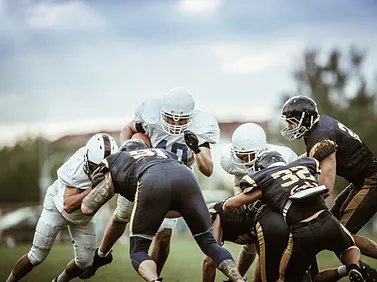Cervical Radiculopathy
Injury Guide

Cervical radiculopathy is a condition that can affect athletes, causing pain and discomfort in the neck, shoulder, arm, and hand. It occurs when a nerve in the cervical spine becomes compressed or irritated, often due to a herniated disc, bone spur, or spinal stenosis. Athletes engaged in high-impact sports or those who frequently engage in repetitive overhead motions are particularly susceptible to this condition.
Symptoms:
The symptoms of cervical radiculopathy can vary but often include neck pain that radiates down the arm, numbness or tingling sensations in the affected arm or hand, and muscle weakness. Athletes may experience difficulty with fine motor skills and grip strength, which can significantly impact their performance and overall athletic abilities. It is crucial to address these symptoms promptly to prevent further complications and optimize athletic performance.
Anatomy:
Cervical radiculopathy involves the compression or irritation of a nerve root in the cervical spine, specifically where the nerve exits the spinal column. The cervical spine consists of seven vertebrae (C1 to C7) and is responsible for providing support, stability, and flexibility to the neck and head. Between each vertebra, there are intervertebral discs that act as shock absorbers and allow for smooth movement.
The nerves that extend from the cervical spine are called cervical nerve roots. These nerve roots transmit sensory and motor information between the brain and the upper extremities, including the arms and hands. Each cervical nerve root corresponds to a specific area in the upper body, and compression or irritation of these nerve roots can lead to characteristic symptoms.
When a cervical nerve root is affected by compression or irritation, it can result in pain, numbness, tingling, and weakness along the pathway of the affected nerve. The specific symptoms experienced by athletes with cervical radiculopathy depend on which nerve root is impacted. For instance, the compression of the C6 nerve root may result in pain and weakness in the biceps and wrist extensor muscles; Whereas the compression of the C7 nerve root may result in pain, numbness, and weakness along the triceps muscle and into the middle finger.
The implications of cervical radiculopathy on athletes are significant. The pain and sensory disturbances can impact an athlete’s ability to perform at their best. Decreased grip strength, impaired coordination, and loss of fine motor skills can influence an athlete’s ability to catch, throw, or manipulate equipment effectively. Additionally, athletes may experience limitations in range of motion, making certain movements or positions difficult or painful to execute.
Moreover, athletes who rely heavily on overhead activities, such as throwing, serving, or weightlifting, may find these actions particularly challenging due to the increased stress placed on the cervical spine and affected nerve roots. The risk of re-injury or exacerbation of symptoms becomes a concern, as athletes may continue to engage in their sport without proper rehabilitation and modifications to their training techniques.
Causes:
There are several causes of cervical radiculopathy, and identifying the underlying source is essential for effective treatment. Athletes may develop this condition due to repetitive stress on the cervical spine, poor posture, or a previous injury. Additionally, age-related degenerative changes in the spine can contribute to the development of radiculopathy. Understanding the cause allows healthcare professionals to tailor rehabilitation strategies to each athlete’s specific needs.
Rehab Strategies:
Rehabilitation strategies for cervical radiculopathy focus on reducing pain, improving mobility, and restoring strength and function. Physical therapy plays a vital role in the recovery process for athletes. Treatment plans often include a combination of manual therapy techniques, therapeutic exercises, and modalities.
Manual therapy techniques, such as joint mobilizations and soft tissue mobilizations, can help alleviate pain and restore normal joint and tissue function. Skilled physical therapists utilize their hands to apply targeted pressure and movement to affected areas, promoting healing and reducing inflammation.
Therapeutic exercises are crucial for rehabilitating athletes with cervical radiculopathy. These exercises aim to strengthen the muscles supporting the cervical spine, improve posture, and increase overall flexibility. Athletes may engage in exercises targeting the neck, shoulder, and upper back, designed to improve stability and reduce strain on the affected nerves.
Modalities like heat therapy, cryotherapy, electrical stimulation, and traction may be incorporated into the treatment plan to provide pain relief, reduce inflammation, and promote tissue healing. These modalities can complement the manual therapy and exercise components of rehabilitation, helping athletes recover faster and return to their sport.
Additionally, education and lifestyle modifications are essential for athletes with cervical radiculopathy. Physical therapists educate athletes about proper body mechanics, posture, and ergonomics to prevent future episodes and minimize the risk of re-injury. They may also provide guidance on modifying training techniques or equipment to accommodate the athlete’s condition while maintaining performance.
Cervical radiculopathy can be a debilitating condition for athletes, affecting their performance and quality of life. Rehabilitation strategies that combine manual therapy, therapeutic exercises, and modalities are effective in managing the symptoms, restoring function, and preventing future recurrences. By seeking physical therapy early on, athletes can optimize their recovery, regain strength and mobility, and return to their sport with confidence.
Let’s
Work
Together
Ready to get started? Click here. General questions? Read our FAQ page. Have a specific question? Leave us a message!
